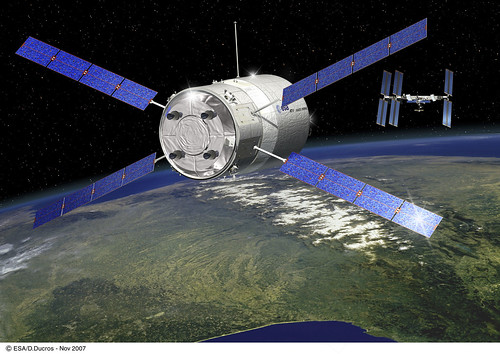Heavy, Heavy Jules Verne
-
Led Zeppelin: "Stairway To Heaven"
-
John Lennon: "Imagine
-
Mika: "Grace Kelly"
-
Louis Armstrong: "What A Wonderful World"
-
Avril Lavigne: "Girlfriend"
Those were the top five songs submitted by students from member states in the European Space Agency’s competition to determine which songs get included in a playlist being carried by the ESA’s Automated Transfer Vehicle (ATV). The songs will be download and enjoyed by the astronauts. Not sure if the RIAA let this one through. Here’s the winning playlist, sumitted by 14-year-old Therese Miljeteig of Norway:
The Beatles: "Here Comes The Sun"
Frank Sinatra: "Come Fly With Me"
Elton John: "Rocket Man"
Joe Cocker and Jennifer Warnes: "Up Where We Belong"
John Lennon: "Imagine"
Irene Cara: "What A Feeling" (from Flashdance)
Dire Straits: "Walk of Life"
Celine Dion: "Fly"
Status Quo: "Rockin’ All Over The World"
R Kelly: "I Believe I Can Fly"
The ATV, the "Jules Verne," will also carry become the Ariane 5’s heaviest payload at 20.7 tons when it launches this weekend (9 March 2008) from Europe’s Spaceport in Kourou, French Guiana.

Wait a minute. Was that 20.7 tons?! That’s got to be double their heaviest payload ever. But if you think about it, the previous record was for launching into geosynchronous transfer orbit, which is much, much higher than the International Space Station’s.
According to yesterday’s piece in the New York Times, this increases the ESA’s ISS participation substantially:
Jean-Jacques Dordain, director general of the European Space Agency, said the inauguration of A.T.V. flights — along with last month’s delivery of the Columbus science module and activation of a European control center — cements Europe’s major new role in space.
"This makes us full partners and a significant player in the space station and space in general," Mr. Dordain said of his organization, which represents 17 European nations. The supply vehicle, Columbus laboratory and other components represent Europe’s investment of more than $7 billion in the station project.
Jules Verne and at least four spacecraft like it are to be launched to the station about every 18 months. Until now, American space shuttles and Russian Progress cargo ships have been the main lifeline to the station.
Michael Suffredini, NASA station program manager, noted that the European craft carries almost three times as much cargo as a Progress and will have an increasingly significant role. "It will be most important after 2010, when the space shuttle retires," he said.
The Jules Verne is the first fully automatic cargo spacecraft of its kind. After launch, it is designed to fly itself to the vicinity of the space station and use a unique system of laser-optical sensors to rendezvous and dock with no human assistance.
The ESA published a great video on the project. Enjoy: